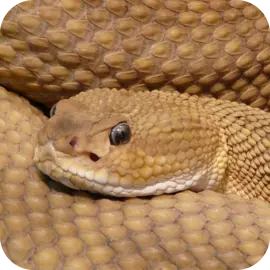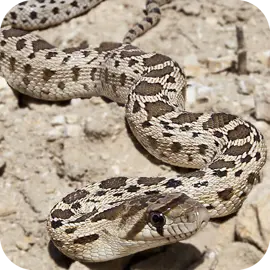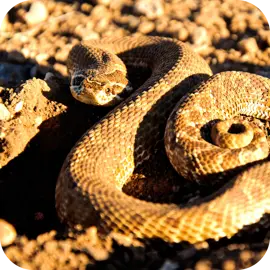Hogle Zoo Rattlesnakes Brochure
Wild Aware Utah Seven Deadly Snakes Flyer
Wild Aware Utah Snakes Flyer
Wild Aware Utah Welcome to Snake Country Flyer
Wild Aware Utah Welcome to Snake Country Handout
Wild Aware Utah Which is Which Flyer
Wild Aware Utah Wildlife Flyer
Snake Awareness

Utah is home to 31 different species and subspecies of snakes, of which seven are venomous rattlesnakes. All snakes are cold-blooded and regulate their body temperatures by basking in the sun or retreating to the cool shade. Snakes hibernate during the winter under rocks and in burrows. In the summer they are most active at dawn and dusk. Rattlesnakes can be found in all types of habitats, from grasslands, lakes and rivers, to deserts or forests. In other words, rattlesnakes can potentially be found anywhere in Utah!
People have been fascinated by and fearful of snakes for centuries. Snakes are depicted in ancient artwork and have been revered in worship and used in symbolism throughout the world. Snakes are very important in controlling the population of rodents and insects, although they will also eat birds and other reptiles. Having snakes around can be helpful for farmers, since rodents and insects can decimate crops and stored food supplies. Rodent-borne diseases can adversely affect more people a year than those bitten by snakes.
The venomous snakes in Utah have broad, triangular-shaped heads, and vertical eye pupils. There are heat sensory “pits” on each side of the snake’s head between the nostrils and eyes. Most venomous snakes in Utah have rattles on their tails, and one set of underside scales. Non-venomous snakes have longer snouts and round pupils, with two sets of underside scales. If you can’t tell if the snake is venomous from a distance, leave it alone and retreat as if it were venomous.

Some species of non-venomous snakes mimic rattlesnake behavior to protect themselves from predators. One suck species is the bull snake, also known as a gopher snake, which is frequently found in Utah. Yellowish cream in color with blotches on their backs that can be black or brown, bull snakes will hiss and shake their tails like rattlesnakes do. It is intended to fool predators into thinking they are venomous snakes. Bull snakes are often mistaken for rattlesnakes and killed by humans out of fear.
Avoid Conflicts
Under Utah law, indiscriminate killing of snakes and all other reptiles is prohibited. It is also against Utah law to allow dogs to harass wildlife. Although most encounters with snakes in Utah are not dangerous and rattlesnakes in particular are rarely aggressive, it is important to learn how to keep yourself, your family and pets safe.
- Never try to poke, handle, corner or harass a snake. Whether venomous or not, all snakes can bite if they feel threatened.
- Be aware of your surroundings. Look carefully where you place your hands and feet, especially in the summer.
- Be alert when living in snake country. Snakes hide well.
- Wear closed-toed shoes, preferably high boots, when hiking.
- Stay on paths and cleared areas. If you must travel in brush or tall grass, use a stick to sweep the area as you walk.
- Do not gather firewood at night when snakes are more active. Be careful reaching into woodpiles, stacked building materials or brush piles.
- Use a floored tent with a zipper door when camping. Don't walk around the campsite in the dark without a flashlight. Keep shoes and clothing inside the tent.
- Look carefully before sitting on the ground, rocks and logs.
- Supervise pets when outside and leash dogs while recreating.
- If you hear a snake's rattle, don't jump or panic. Try to locate where the sound is coming from before trying to move. When the source of the sound is identified, back away slowly and make sure you have a clear space to exit and not trip or fall. Warn others if they are around.
- If you encounter a venomous snake away from human developments, leave it alone. It is in its natural environment.
- If you are unsure if a snake is venomous, do not try to pick it up.
- Teach children to leave snakes alone.
- Purchase a snake bit kit to take with you when camping or hiking. These kits can be purchased from most outdoor gear companies.

Dealing With Bites
If threatened, rattlesnakes will coil, begin to hiss, and shake their rattles. This is a warning to leave. Rattlesnakes can strike quickly in any direction, from any position. Striking in defense is their last resort. It is important to know that deaths from snake bites are very rare. However, injuries require proper treatment:
- If bitten, treat the bite as if it were venomous. Seek medical treatment immediately. If pets are bitten, seek veterinary treatment immediately.
- Treat for shock and temperature extremes.
- Remove tight clothing or jewelry from the bite area.
- Keep the affected area below the level of the heart.
- Get a description of the snake if possible.
- DO NOT try to cut and suck the venom from the wound. Do not apply cold packs to the wound. Never use a tourniquet.
Snakes and Your Home
As mentioned above, snakes can be found in any environment throughout the state. While more likely to be discovered in the wild, snakes can be found in neighborhoods and suburbs, gullies and backyards. To help deter snakes at your home and protect your family and pets:
- Supervise children and pets outside.
- Trim vegetation and remove wood and rock piles to reduce hiding places.
- Control rodents on your property; remove bird feeders, and attractant of rodents.
- Seal any cracks in building foundations, porches, pipes and windows.
- Install a snake-proof fence around your property.
If you encounter snakes on your property, contact Animal Control at (801) 840-4000 during business hours to safely have them removed. During the weekend, contact the Utah Division of Wildlife Resources at (801) 538-7200.

